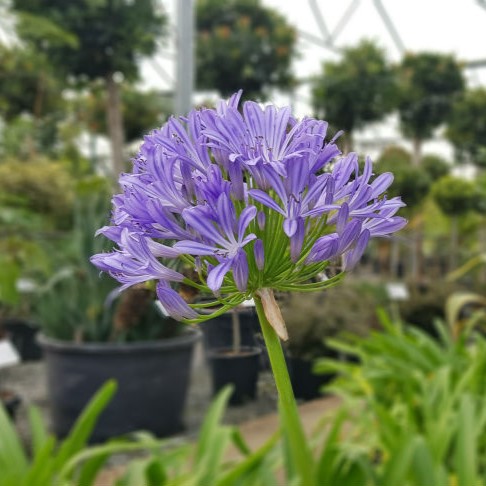Growing Agapanthus: A Full Overview to Beautiful Blooms
Growing Agapanthus: A Full Overview to Beautiful Blooms
Blog Article
Releasing the Secret to Effective Agapanthus Farming: Advice for a Flourishing Yard
In the world of gardening, growing agapanthus effectively needs a strategic strategy that includes different elements of plant care. By understanding the subtleties of agapanthus cultivation, one can produce an atmosphere where these plants prosper and grow perfectly.
Growing Agapanthus: Finest Practices
When growing Agapanthus, correct soil preparation is crucial for making certain effective development and advancement of these attractive blossoms. Agapanthus, commonly referred to as Lily of the Nile or African lily, thrives in well-draining soil with a somewhat acidic to neutral pH level - Agapanthus. Prior to planting, it is critical to amend hefty clay soils with raw material such as compost or peat moss to enhance drainage and supply essential nutrients for the plants
To plant Agapanthus, select a location that gets complete sunlight to partial shade, as this will certainly promote healthy and balanced growth and plentiful blooming. Dig a hole two times the size of the plant's origin sphere and place the Agapanthus at the exact same depth it was formerly expanding. Gently backfill the hole with dirt, pressing down securely to remove any air pockets around the origins.
Water the freshly grown Agapanthus thoroughly and continue to keep the soil equally wet, especially throughout the plant's energetic expanding season. Agapanthus. Applying a well balanced plant food once a month can further sustain the plant's growth and flowering. By complying with these best methods for growing Agapanthus, you can develop a sensational screen of these exciting flowers in your garden
Ideal Soil Conditions for Agapanthus
For optimum development and flowering success of Agapanthus plants, ensuring the soil conditions are optimal is vital. Agapanthus likes soil that is abundant in nutrients, so including a well balanced fertilizer during the growing period can advertise healthy and balanced growth and vivid blooms.
Watering and Feeding Tips
To guarantee healthy development and vivid blooms, appropriate watering and feeding methods are essential for successful Agapanthus farming. Agapanthus plants profit from normal watering, especially during the expanding period. It is suggested to water deeply when a week, making sure the soil is visit site damp but not soaked. During warm weather or in pots, even more constant watering might be essential to avoid the dirt from drying out entirely.
When it pertains to feeding Agapanthus, a well balanced plant food with equal parts nitrogen, phosphorus, and potassium can be used in the springtime to promote healthy growth and blooming. Slow-release plant foods are excellent for offering nutrients gradually over an extended period. Stay clear of over-fertilizing, as this can cause excessive foliage growth at the expenditure of blossoms.
In addition, including raw material like garden compost into the soil can boost nutrient degrees and boost dirt framework, helping in the total wellness of the Agapanthus plants. By following these watering and feeding ideas, garden enthusiasts can guarantee their Agapanthus plants thrive and create sensational displays of blossoms.
Pruning and Deadheading Strategies
Proper pruning and deadheading strategies play a crucial role in maintaining the wellness and aesthetic appeals of Agapanthus plants, enhancing the important practices of watering and feeding for successful farming. Pruning Agapanthus entails getting additional resources rid of invested flower heads, dead or yellowing fallen leaves, and total shaping of the plant to promote far better development. Deadheading, the procedure of eliminating discolored flowers, not just boosts the plant's appearance but likewise motivates more blooming.
When deadheading Agapanthus, it is advisable to trim off the blossom stem at the base utilizing sharp, tidy shears. This process reroutes the plant's energy from seed production back right into root and vegetation development, advertising a healthier and much more robust plant. Regular deadheading can expand the blooming period of Agapanthus and prevent self-seeding, which can result in congestion.
In terms of trimming, Agapanthus generally advantages from a light trim after blossoming to tidy up the plant and motivate fresh growth. Reducing the invested flower stems and eliminating any type of dead or damaged vegetation helps maintain the plant's vitality and general look. Nonetheless, it is vital to stay clear of reducing right into the crown of the plant, as this can damage its health and wellness.

Protecting Agapanthus From Pests and Diseases
Executing reliable pest and disease management strategies is essential to protecting the wellness and vitality of Agapanthus plants in farming. One typical insect that affects Agapanthus is the Agapanthus borer, a caterpillar that tunnels into the plant, creating damage to the blossoms and fallen leaves.
In addition to parasites, Agapanthus are prone to conditions such as root rot and fungal fallen leave spots. By remaining alert and resolving bug and disease problems quickly, gardeners can aid their Agapanthus prosper and grow.

Conclusion
In verdict, successful growing of agapanthus needs appropriate planting strategies, excellent soil problems, adequate watering and fertilizing, routine pruning and deadheading, and protection from bugs and conditions. view website By adhering to these ideas and tricks, gardeners can make sure a growing garden loaded with gorgeous agapanthus flowers. Agapanthus. Bear in mind to preserve constant care and attention to information to promote the health and durability of these sensational plants
When growing Agapanthus, appropriate dirt prep work is necessary for making sure effective growth and growth of these beautiful blossoms.Water the recently grown Agapanthus completely and proceed to maintain the soil equally damp, specifically throughout the plant's energetic growing period.For ideal development and growing success of Agapanthus plants, making certain the soil problems are ideal is essential. When hair transplanting or growing Agapanthus, make certain the dirt is well-prepared to offer the required foundation for the plants to develop themselves efficiently. One common bug that impacts Agapanthus is the Agapanthus borer, a caterpillar that passages into the plant, causing damages to the fallen leaves and blossoms.
Report this page